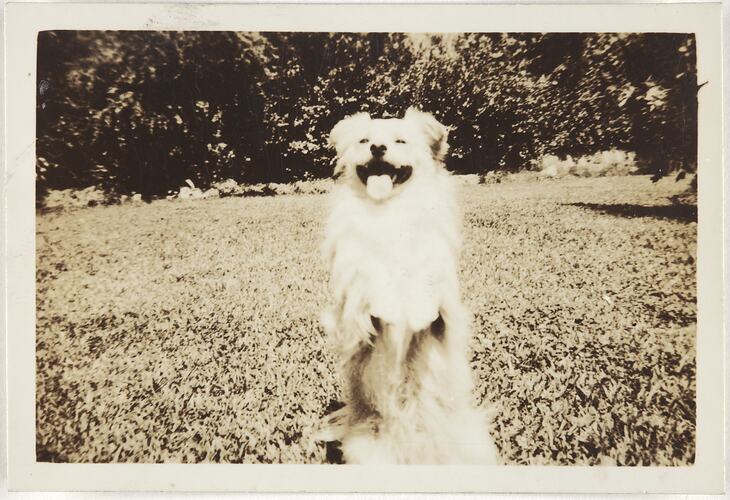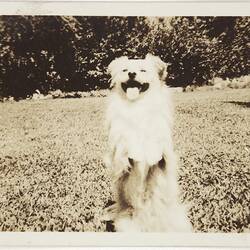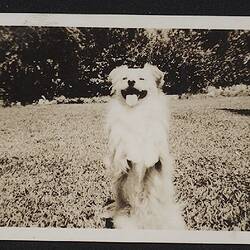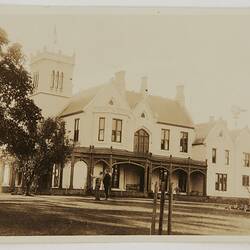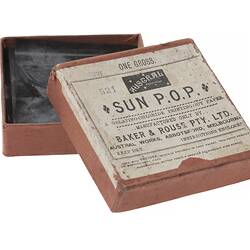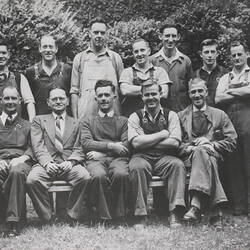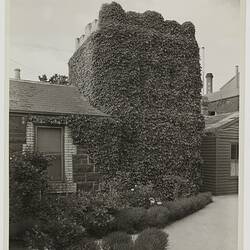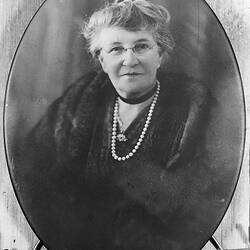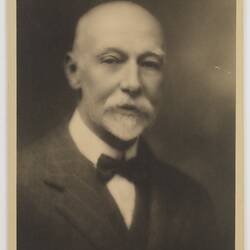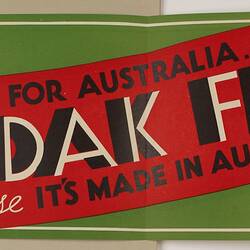Summary
Black and white photograph of Skipper, a Pomeranian crossbreed dog, sitting on his hind legs, 'begging', in the garden area of the Kodak Australasia Pty Ltd factory site in Abbotsford, in the early 1940s. This photograph highlights the intersection between the domestic and the industrial that occured at this site around World War II, which was an unusual and unique experience in Kodak's manufacturing history.
Skipper belonged to Harry Clarke, a young boy who lived on the Kodak factory site in Abbotsford with his parents. Harry remembered that Skipper 'was a great companion'.
Harry's mother was the chef in the Kodak directors' dining room and his father worked in silver recovery and then later was a gardener at Kodak. The family lived at the 'Yarra Grange' house from 1938, when Harry was twelve years old, until 1952, when he was twenty six years old. They were the only people who lived onsite at the factory.
Harry says that 'When I lived at Kodak it was a huge, very huge place, and I seemed to live a very privileged life for a small child, I had the virtual run of the factory excepting some sections, particularly during the war years.... The staff at Kodak were like a large family. ...everybody seemed to be very friendly and supportive, the dining room I think provided meals free of charge, there was a lot of benevolence in that period of time.'
Description of Content
Black and white photograph of a dog in a garden sitting on its hind legs, 'begging'. The dog is sitting on a grassed area, and there are large trees in the background.
Physical Description
Digital image file. A digital photograph was taken of the original black and white print. Image of a dog sitting in a garden with white border.
Significance
This photograph is one of four images that contextualises an important part of the Kodak Australasia Pty Ltd's manufacturing history in Melbourne, when a family lived onsite at the Abbotsford factory from about 1938 - 1952, in the period around World War II. This photograph highlights the intersection between the domestic and the industrial that occured at this site, which was an unusual and unique experience. Company research and an oral history of the Clarke family experience at Kodak provide a good historical framework to the photographs.
More Information
-
Collection Names
-
Collecting Areas
-
Acquisition Information
Donation from Harry Clarke, Oct 2009
-
Organisation Depicted
Kodak (Australasia) Pty Ltd, Abbotsford, Greater Melbourne, Victoria, Australia, early 1940s
The owner of the dog was twelve in 1938 when he moved to live at the Kodak factory site, but in a photograph with the dog taken about the same time as this one, looks slightly older than twelve, so a date of early 1940s has been suggested. -
Format
Digital file, 1.5 x 2.5, Black & White
-
Inscriptions
On original print - Printed, purple ink, back: 'KODAK PRINT' (enclosed in a circle) Printed, black ink, back:'Velox' (enclosed in an oval) Stamped, blue ink, back: '1 6'
-
Classification
-
Category
-
Discipline
-
Type of item
-
Image Dimensions
65 mm (Width), 40 mm (Height)
-
Keywords
Dogs, Domestic Life, Factories, Factory Workers, Gardens, Pets, Trees
